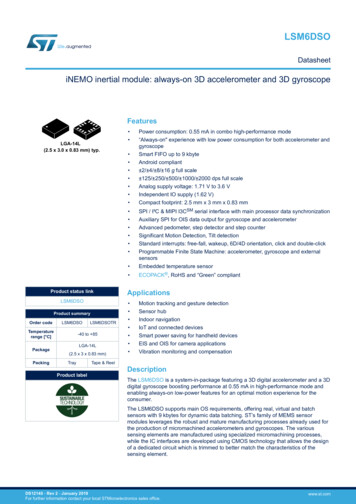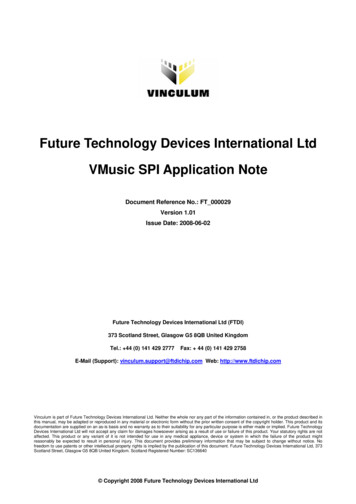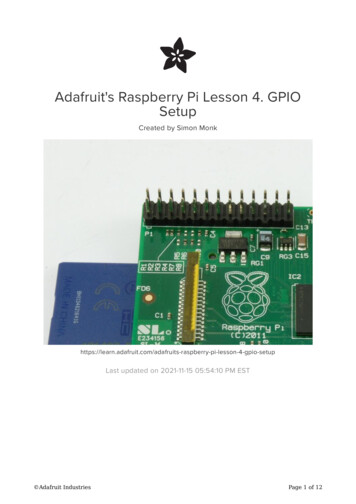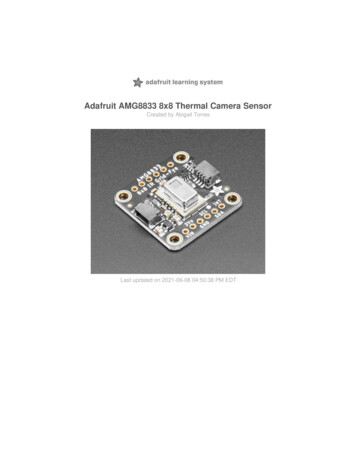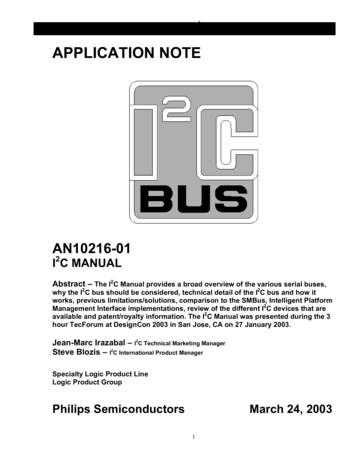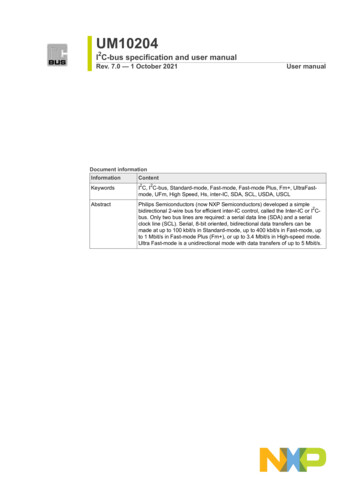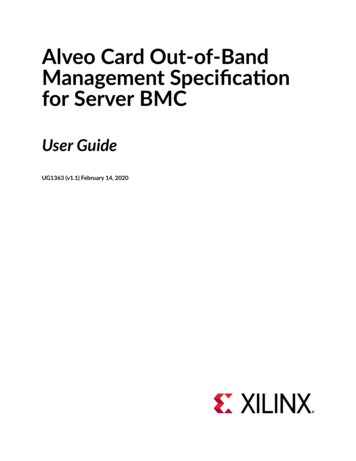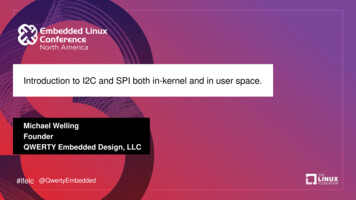
Transcription
Introduction to I2C and SPI both in-kernel and in user space.Michael WellingFounderQWERTY Embedded Design, LLC#lfelc @QwertyEmbedded
I2C Overview What is I2C?Example I2C DevicesI2C ProtocolLinux I2C SubsystemLinux I2C Drivers– I2C Bus Drivers– I2C Device Drivers– I2C Slave Interface Instantiating I2C Devices User space tools Demo#lfelc
What is I2C? I2C stands for inter-integrated circuitFirst developed by Philips Semiconductor in 1982,currently owned by NXP SemiconductorsSynchronous multi-master multi-slave serial busHalf duplex protocolOpen-drain signalingOnly two signal wires––SDA: serial dataSCL: serial clocken:user:Cburnett, I2C, CC BY-SA 3.0https://en.wikipedia.org/wiki/I%C2%B2C#lfelc
What is I2C? I2C addressing is typically 7 bits per the originalspecificationI2C clock speed is typically 100KHz per the originalspecificationLater versions of the specification introduced fasterclock modes and 10 bit addressing––––Version 1 added 400KHz Fast mode and 10 bitaddressingVersion 2 added 3.4MHz Hs modeVersion 3 added 1MHz Fast mode and ID mechanismVersion 4 added unidirectional 5Mhz Ultra Fast mode#lfelc
What is I2C? SMBus (System Management Bus) is a2subset of I C defined by Intel–Typically used on PC motherboards for powercontrol and sensors–Stricter tolerances on voltage levels and timing–Adds an optional software level addressresolution protocol#lfelc
Example I2C Devices Real time clockEEPROMAnalog converters (ADC, DAC)Sensors (Temperature, Pressure)MicrocontrollersTouchscreen controllersGPIO expandersMonitor and TV adapters#lfelc
Example I2C Hardware#lfelc
I2C ProtocolStartSDA goes low before SCL to signal the start of transmission.Addr7 bit address that determines the slave device to be accessed.R/WDataACKTransaction data direction bit. (1 read, 0 write)Byte data read from or written to the slave device. Can be multiple bytes.Acknowledge bit. (0 ack, 1 nak)StopSDA goes high after SCL to signal the end of transmission.#lfelc
Linux I2C Subsystem Early implementations were from GerdKnorr and Simon G. Vogl.Migrated to the device model by Greg KH inlate 2.5 versions of Linux.Integrated into standard device drivermodel by David Brownell and Jean Delvarein Linux 2.6.Currently maintained by Wolfram Sang.#lfelc
Linux I2C Subsystemhttps://i2c.wiki.kernel.org#lfelc
Linux I2C SubsystemList: linux-i2c;( subscribe / unsubscribe )Info:Linux kernel I2C bus layer mailing list.Archives:http://marc.info/?l felc
Linux I2C DriversI2C Bus DriversBus AlgorithmAdapterAn Algorithm driver contains general code that can be used for awhole class of I2C adapters. Each specific adapter driver eitherdepends on one algorithm driver, or includes its entation/i2c/summary#lfelc
Linux I2C DriversI2C Bus Driver Define and allocate a private data struct (contains struct i2c adapter) Fill algorithm struct–– Fill adaptor struct––– .master xfer() – function to perform transfer.functionality() – function to retrieve bus functionality.i2c set adapdata().algo – pointer to algorithm struct.algo data – pointer the private data structAdd adapter–i2c add adapter()#lfelc
Linux I2C DriversI2C Device DriversDevice DriverClientA Driver driver (yes, this sounds ridiculous, sorry) contains thegeneral code to access some type of device. Each detected devicegets its own data in the Client structure. Usually, Driver and Clientare more closely integrated than Algorithm and 2c/summary#lfelc
Linux I2C DriversI2C Device Driveri2c driverstatic struct i2c driver foo driver {.driver {.name "foobar",.of match table of match ptr(foo dt ids)},.id table foo idtable,.probe foo probe,.remove foo remove,};#lfelc
Linux I2C DriversI2C Device Driveri2c device id / of device idstatic struct i2c device id foo idtable[] {{ "foo", 0 },{}};MODULE DEVICE TABLE(i2c, foo idtable);static const struct of device id foo dt ids[] {{ .compatible "foo,bar", .data (void *) 0xDEADBEEF },{}};MODULE DEVICE TABLE(of, foo dt ids);#lfelc
Linux I2C DriversI2C Device DriverProbe functionstatic int foo probe(struct i2c client *client, const struct i2c device id *id){int ret;pr info("foo probe called\n");if (client- dev.of node) {pr info("device tree instantiated probe. data %x\n",(unsigned int)of device get match data(&client- dev));}ret i2c smbus read byte data(client, 0x0d);pr info("i2c read byte %x\n", ret);if (ret 0)return ret;return 0;}#lfelc
Linux I2C DriversI2C Device DriverRemove functionstatic int foo remove(struct i2c client *client){/* do any cleanup here*/pr info("foo remove called\n");return 0;}#lfelc
Each client structure has a special data field that can point to any structure at all. You should use this to keep device-specific data.Linux I2C DriversI2C Device DriverClient dataEach client structure has a special data field that can pointto any structure at all. You should use this to keep devicespecific data./* store the value */void i2c set clientdata(struct i2c client *client, void *data);/* retrieve the value */void *i2c get clientdata(const struct i2c client *client);#lfelc
Linux I2C DriversI2C Device DriverInitializing the driverstatic int init foo init(void){return i2c add driver(&foo driver);}module init(foo init);static void exit foo cleanup(void){i2c del driver(&foo driver);}module exit(foo cleanup);The module i2c driver() macro can be used to reduce above code.module i2c driver(foo driver);#lfelc
Linux I2C DriversI2C Device DriverPlain I2C APIint i2c master send(struct i2c client *client, const char *buf,int count);int i2c master recv(struct i2c client *client, char *buf, int count);These routines read and write some bytes from/to a client. The client contains the I2C address, so you do nothave to include it. The second parameter contains the bytes to read/write, the third the number of bytes toread/write (must be less than the length of the buffer, also should be less than 64k since msg.len is u16.) Returnedis the actual number of bytes read/written.int i2c transfer(struct i2c adapter *adap, struct i2c msg *msg,int num);This sends a series of messages. Each message can be a read or write, and they can be mixed in any way. Thetransactions are combined: no stop condition is issued between transaction. The i2c msg structure contains foreach message the client address, the number of bytes of the message and the message data itself.#lfelc
Linux I2C DriversI2C Device DriverSMBus I2C APIs32 i2c smbus read byte(struct i2c client *client);s32 i2c smbus write byte(struct i2c client *client, u8 value);s32 i2c smbus read byte data(struct i2c client *client, u8 command);s32 i2c smbus write byte data(struct i2c client *client,u8 command, u8 value);s32 i2c smbus read word data(struct i2c client *client, u8 command);s32 i2c smbus write word data(struct i2c client *client,u8 command, u16 value);s32 i2c smbus read block data(struct i2c client *client,u8 command, u8 *values);s32 i2c smbus write block data(struct i2c client *client,u8 command, u8 length, const u8 *values);s32 i2c smbus read i2c block data(struct i2c client *client,u8 command, u8 length, u8 *values);s32 i2c smbus write i2c block data(struct i2c client *client,u8 command, u8 length,const u8 *values);#lfelc
Linux I2C DriversI2C Slave Interface.e.g. sysfsI2C slave eventsI/O registers ----------- v --------- v -------- v ------------ Userspace . Backend ----------- Driver ----- Controller ----------- --------- -------- ------------ -------------- -- --------------- ---- Busecho slave-24c02 0x1064 /sys/bus/i2c/devices/i2c-1/new /slave-interface#lfelc
Instantiating I2C DevicesDevice treei2c1: i2c@400a0000 {/* . master properties skipped . */clock-frequency 100000 ;flash@50 {compatible "atmel,24c256";reg 0x50 ;};pca9532: gpio@60 {compatible "nxp,pca9532";gpio-controller;#gpio-cells 2 ;reg 0x60 ;};};#lfelc
Instantiating I2C DevicesPlatform devicestatic struct i2c board info h4 i2c board info[] initdata {{I2C BOARD INFO("isp1301 omap", 0x2d),.irq OMAP GPIO IRQ(125),},{/* EEPROM on mainboard */I2C BOARD INFO("24c01", 0x52),.platform data &m24c01,},{/* EEPROM on cpu card */I2C BOARD INFO("24c01", 0x57),.platform data &m24c01,},};static void init omap h4 init(void){(.)i2c register board info(1, h4 i2c board info,ARRAY SIZE(h4 i2c board info));(.)}#lfelc
Instantiating I2C DevicesFrom user spaceecho eeprom 0x50 /sys/bus/i2c/devices/i2c-3/new /instantiating-devices#lfelc
User space Tools Simple character device driver (i2c-dev)–––– Device nodes at /dev/i2c-xSlave address set by I2C SLAVE ioctl.Simple access using read() / write()i2c smbus {read,write} {byte,word} ce#lfelc
User space ToolsFrom the Linux user space, you can access the I2Cbus from the /dev/i2c-* device files.debian@beaglebone: ls -l /dev/i2c-*crw-rw---- 1 root i2c 89, 0 Oct 7 16:40 /dev/i2c-0crw-rw---- 1 root i2c 89, 1 Oct 7 16:40 /dev/i2c-1crw-rw---- 1 root i2c 89, 2 Oct 7 16:40 /dev/i2c-2#lfelc
User space ToolsList I2C devices on the busdebian@beaglebone: i2cdetect -y0 1 2 3 4 5 6 7 8 9 a b c d e f00: -- -- -- -- -- -- -- -- -- -10: -- -- -- -- -- -- -- -- -- -20: -- -- -- -- -- -- -- -- -- -30: -- -- -- -- -- -- -- -- -- -40: -- -- -- -- -- -- -- -- -- -50: -- -- -- -- -- -- -- -- -- -60: -- -- -- -- -- -- -- -- -- -70: -- -- -- -- -- -- -- ---r elc
User space ToolsDump the register contents of MMA8453debian@beaglebone: i2cdump -y -r 0x00-0x31 2 0x1cNo size specified (using byte-data access)0 1 2 3 4 5 6 7 8 9 a b c d e f 0123456789abcdef00: ff fe 00 01 80 41 80 00 00 00 00 01 00 3a 00 00 .?.?A?.?.:.10: 00 80 00 44 84 00 00 00 00 00 00 00 00 00 00 00 .?.D?.20: 00 00 00 00 00 00 00 00 00 00 01 00 00 00 00 00 .?.30: 00 00#lfelc
User space ToolsRead and write single registers of the MMA8453debian@beaglebone: 0x3adebian@beaglebone: 0x00debian@beaglebone: debian@beaglebone: 0x01i2cget -y 2 0x1c 0x0di2cget -y 2 0x1c 0x2ai2cset -y 2 0x1c 0x2a 0x01i2cget -y 2 0x1c 0x2a#lfelc
Demo
SPI Overview What is SPI?Example SPI DevicesSPI ModesLinux SPI SubsystemLinux SPI Drivers– Controller Drivers– Protocol Drivers Kernel APIs Instantiating SPI Devices User space tools Demo#lfelc
What is SPI? SPI (Serial Peripheral Interface) is a full duplexsynchronous serial master/slave bus interface De facto standard first developed at Motorola in the1980s A SPI bus consists of a single master device andpossibly multiple slave devices Typical device interface–––––SCLK – serial clockMISO – master in slave outMOSI – master out slave inCSn / SSn – chip select / slave selectIRQ / IRQn – interrupten:user:Cburnett, SPI, CC BY-SA 3.0#lfelc
What is SPI?#lfelc
Example SPI devices Analog converters (ADC, DAC, CDC)Sensors (inertial, temperature, pressure)Serial LCDSerial FlashTouchscreen controllersFPGA programming interface#lfelc
SPI Modes SPI Mode is typically represented by (CPOL,CPHA) tuple– CPOL – clock polarity 0 clock idles low 1 clock idles high– CPHA – clock phase 0 data latched on falling clock edge, output on rising 1 data latched on rising clock edge, output on falling Mode (0, 0) and (1, 1) are most commonlyused Sometimes listed in encoded form 0-3#lfelc
SPI ModesSPI Mode Timing – CPOL 0#lfelc
SPI ModesSPI Mode Timing – CPOL 1#lfelc
Linux SPI SubsystemFirst developed in early 2000s (2.6 ERA) basedon the work of several key developers inincluding:–––––––David BrownellRussell KingDmitry PervushinStephen StreetMark UnderwoodAndrew VictorVitaly Wool#lfelc
Linux SPI SubsystemPast maintainers of the Linux SPI subsystem:– David Brownell– Grant LikelyCurrent maintainer:– Mark Brown#lfelc
Linux SPI SubsystemList: linux-spi;( subscribe / unsubscribe )Info:This is the mailing list for the Linux SPIsubsystem.Archives: http://marc.info/?l linux-spi#lfelc
Linux SPI DriversController Drivers Controller drivers are used to abstract anddrive transactions on an SPI master. The host SPI peripheral registers areaccessed by callbacks provided to the SPIcore driver. (drivers/spi/spi.c) struct spi controller#lfelc
Linux SPI DriversController Drivers Allocate a controller– spi alloc master() Set controller fields and methods– mode bits - flags e.g. SPI CPOL, SPI CPHA, SPI NO CS, SPI CS HIGH,SPI RX QUAD, SPI LOOP– .setup() - configure SPI parameters– .cleanup() - prepare for driver removal– .transfer one message()/.transfer one() - dispatch one msg/transfer(mutually exclusive) Register a controller– spi register master()#lfelc
Linux SPI DriversController Devicetree BindingThe SPI controller node requires the following properties:compatible - Name of SPI bus controller following generic names recommended practice.In master mode, the SPI controller node requires the following additional properties:#address-cells - number of cells required to define a chip select address on the SPI bus.#size-cells - should be zero.Optional properties (master mode only):cs-gpios - gpios chip select.num-cs - total number of chipselects.So if for example the controller has 2 CS lines, and the cs-gpios property looks like this:cs-gpios &gpio1 0 0 , 0 , &gpio1 1 0 , &gpio1 2 0 ;#lfelc
Linux SPI DriversController Devicetree BindingExample:spi1: spi@481a0000 {compatible "ti,omap4-mcspi";#address-cells 1 ;#size-cells 0 ;reg 0x481a0000 0x400 ;interrupts 125 ;ti,spi-num-cs 2 ;ti,hwmods "spi1";dmas &edma 42 0&edma 43 0&edma 44 0&edma 45 0 ;dma-names "tx0", "rx0", "tx1", "rx1";status "disabled";};#lfelc
Linux SPI DriversProtocol Drivers For each SPI slave you intend on accessing, you have aprotocol driver. SPI protocol drivers can be found inmany Linux driver subsystems (iio, input, mtd). Messages and transfers are used to communicate toslave devices via the SPI core and are directed to therespective controller driver transparently. A struct spi device is passed to the probe and removefunctions to pass information about the host.#lfelc
Linux SPI DriversProtocol Drivers Transfers– A single operation between master and slave– RX and TX buffers pointers are supplied– Option chip select behavior and delays Messages– Atomic sequence of transfers– Argument to SPI subsystem read/write APIs#lfelc
Linux SPI DriversProtocol Driversstruct spi devicestruct spi device {struct device dev;struct spi controller * controller;struct spi controller * master;u32 max speed hz;u8 chip select;u8 bits per word;u16 mode;int irq;void * controller state;void * controller data;char modalias;int cs gpio;struct spi statistics statistics;}Controller side proxy for an SPI slavedevice. Passed to the probe and removefunctions with values based on the hostconfiguration.#lfelc
Linux SPI DriversProtocol Drivers#define SPI CPHA 0x01#define SPI CPOL 0x02#define SPI MODE 0 (0 0)#define SPI MODE 1 (0 SPI CPHA)#define SPI MODE 2 (SPI CPOL 0)#define SPI MODE 3 (SPI CPOL SPI CPHA)#define SPI CS HIGH 0x04#define SPI LSB FIRST 0x08#define SPI 3WIRE 0x10#define SPI LOOP 0x20#define SPI NO CS 0x40#define SPI READY 0x80#define SPI TX DUAL 0x100#define SPI TX QUAD 0x200#define SPI RX DUAL 0x400#define SPI RX QUAD 0x800/* clock phase *//* clock polarity *//* (original MicroWire) *//* chipselect active high? *//* per-word bits-on-wire *//* SI/SO signals shared *//* loopback mode *//* 1 dev/bus, no chipselect *//* slave pulls low to pause *//* transmit with 2 wires *//* transmit with 4 wires *//* receive with 2 wires *//* receive with 4 wires */#lfelc
Linux SPI DriversProtocol DriversProbe Functionstatic int myspi probe(struct spi device *spi){struct myspi *chip;struct myspi platform data *pdata, local pdata;.}#lfelc
Linux SPI DriversProtocol DriversProbe Functionstatic int myspi probe(struct spi device *spi){.match of match device(of match ptr(myspi of match), &spi- dev);if (match) {/* parse device tree options */pdata &local pdata;.}else {/* use platform data */pdata &spi- dev.platform data;if (!pdata)return -ENODEV;}.}#lfelc
Linux SPI DriversProtocol DriversProbe Functionstatic int myspi probe(struct spi device *spi){./* get memory for driver's per-chip state */chip devm kzalloc(&spi- dev, sizeof *chip, GFP KERNEL);if (!chip)return -ENOMEM;spi set drvdata(spi, chip);.return 0;}#lfelc
Linux SPI DriversProtocol DriversOF Device TableExample:static const struct of device id myspi of match[] {{.compatible "mycompany,myspi",.data (void *) MYSPI DATA,},{ },};MODULE DEVICE TABLE(of, myspi of match);#lfelc
Linux SPI DriversProtocol DriversSPI Device TableExample:static const struct spi device id myspi id table[] {{ "myspi", MYSPI TYPE },{ },};MODULE DEVICE TABLE(spi, myspi id table);#lfelc
Linux SPI DriversProtocol Driversstruct spi driverstruct spi driver {const struct spi device id * id table;int (* probe) (struct spi device *spi);int (* remove) (struct spi device *spi);void (* shutdown) (struct spi device *spi);struct device driver driver;};#lfelc
Linux SPI DriversProtocol Driversstruct spi driverExample:static struct spi driver myspi driver {.driver {.name "myspi spi",.pm &myspi pm ops,.of match table of match ptr(myspi of match),},.probe myspi probe,.id table myspi id table,};module spi driver(myspi driver);#lfelc
Linux SPI DriversProtocol DriversKernel APIs spi async()––– spi sync()––– asynchronous message requestcallback executed upon message completecan be issued in any contextsynchronous message requestmay only be issued in a context that can sleep (i.e. not in IRQ context)wrapper around spi async()spi write()/spi read()–helper functions wrapping spi sync()#lfelc
Linux SPI DriversProtocol DriversKernel APIs spi read flash()– Optimized call for SPI flash commands– Supports controllers that translate MMIO accesses into standard SPI flashcommands spi message init()– Initialize empty message spi message add tail()– Add transfers to the message’s transfer list#lfelc
Linux SPI DriversInstantiating SPI DevicesSlave Node Devicetree BindingSPI slave nodes must be children of the SPI controller node.In master mode, one or more slave nodes (up to the number of chip selects) canbe present.Required properties are:- compatible - Name of SPI device following generic names recommended practice.- reg - Chip select address of device.- spi-max-frequency - Maximum SPI clocking speed of device in Hz.#lfelc
Linux SPI DriversInstantiating SPI DevicesSlave Node Devicetree BindingAll slave nodes can contain the following optional properties:- spi-cpol - Empty property indicating device requires inverse clock polarity (CPOL) mode.- spi-cpha - Empty property indicating device requires shifted clock phase (CPHA) mode.- spi-cs-high - Empty property indicating device requires chip select active high.- spi-3wire - Empty property indicating device requires 3-wire mode.- spi-lsb-first - Empty property indicating device requires LSB first mode.- spi-tx-bus-width - The bus width that is used for MOSI. Defaults to 1 if not present.- spi-rx-bus-width - The bus width that is used for MISO. Defaults to 1 if not present.- spi-rx-delay-us - Microsecond delay after a read transfer.- spi-tx-delay-us - Microsecond delay after a write transfer#lfelc
Linux SPI DriversInstantiating SPI DevicesSlave Node Devicetree BindingExample:&spi1 {#address-cells 1 ;#size-cells 0 ;status "okay";pinctrl-names "default";pinctrl-0 &spi1 pins ;myspi@0 {compatible "mycompany,myspi";spi-max-frequency 2000000 ;spi-cpha;.reg 0 ;};.};#lfelc
Linux SPI DriversInstantiating SPI DevicesPlatform Registrationstruct spi board info {char modalias;const void * platform data;const struct property entry * properties;void * controller data;int irq;u32 max speed hz;u16 bus num;u16 chip select;u16 mode;};#lfelc
Linux SPI DriversInstantiating SPI DevicesPlatform RegistrationExample:static struct spi board info myspi board info[] {{.modalias "myspi",.platform data &myspi info,.irq MYIRQ,.max speed hz 2000000,.chip select 2, .},};#lfelc
Linux SPI DriversUser space toolsspidevWhat does spidev do? Passes data between user space and SPI controllerCollects buffers for TX/RX from user space applicationHands off buffers to SPI controller driverReturns to user space when transfer is complete#lfelc
Linux SPI DriversUser space toolsspidevWhen should spidev be used? Prototyping in an environment that's not crash-prone; stray pointersin user space won't normally bring down any Linux system.Developing simple protocols used to talk to microcontrollers actingas SPI slaves, which you may need to change quite /spidev#lfelc
Linux SPI DriversUser space toolsspidevWhen should spidev NOT be used? Of course there are drivers that can never be written inuser space, because they need to access kernelinterfaces (such as IRQ handlers or other layers of thedriver stack) that are not accessible to user /spidev#lfelc
Linux SPI DriversUser space toolsspidevSPI devices have a limited user space API, supporting basic half-duplexread() and write() access to SPI slave devices. Using ioctl() requests, fullduplex transfers and device I/O configuration are also available.Required header files:#include fcntl.h #include unistd.h #include sys/ioctl.h #include linux/types.h #include linux/spi/spidev.h #lfelc
Linux SPI DriversUser space toolsspidevThe sysfs node for the SPI device will include a child device node with a “dev”attribute that will be understood by udev or mdev.For a SPI device with chip select C on bus B, you should see: /dev/spidevB.C - character special device, major number 153 with adynamically chosen minor device number. /sys/devices/ /spiB.C - SPI device node will be a child of its SPI mastercontroller. /sys/class/spidev/spidevB.C - created when the “spidev” driver binds tothat device.#lfelc
Linux SPI DriversUser space toolsspidevNormal open() and close() operations on /dev/spidevB.D files workas you would expect.Standard read() and write() operations are obviously only halfduplex, and the chipselect is deactivated between those operations.Full-duplex access, and composite operation without chipselect deactivation, is available using the SPI IOC MESSAGE(N) request.#lfelc
Linux SPI DriversUser space toolsspidev ioctlSeveral ioctl() requests let your driver read or override the device’s current settings fordata transfer parameters:SPI IOC RD MODE, SPI IOC WR MODEPass a pointer to a byte which will return (RD) or assign (WR) the SPI transfer mode. Use theconstants SPI MODE 0.SPI MODE 3; or if you prefer you can combine SPI CPOL (clockpolarity, idle high iff this is set) or SPI CPHA (clock phase, sample on trailing edge iff this isset) flags. Note that this request is limited to SPI mode flags that fit in a single byte.SPI IOC RD MODE32, SPI IOC WR MODE32Pass a pointer to a uin32 t which will return (RD) or assign (WR) the full SPI transfer mode, notlimited to the bits that fit in one byte.#lfelc
Linux SPI DriversUser space toolsspidev ioctlSPI IOC RD LSB FIRST, SPI IOC WR LSB FIRSTPass a pointer to a byte which will return (RD) or assign (WR) the bit justification used totransfer SPI words. Zero indicates MSB-first; other values indicate the less common LSB-firstencoding. In both cases the specified value is right-justified in each word, so that unused (TX)or undefined (RX) bits are in the MSBs.SPI IOC RD BITS PER WORD, SPI IOC WR BITS PER WORDPass a pointer to a byte which will return (RD) or assign (WR) the number of bits in each SPItransfer word. The value zero signifies eight bits.SPI IOC RD MAX SPEED HZ, SPI IOC WR MAX SPEED HZPass a pointer to a u32 which will return (RD) or assign (WR) the maximum SPI transfer speed,in Hz. The controller can’t necessarily assign that specific clock speed.#lfelc
Linux SPI DriversUser space toolsspidevu8 miso[MAX LENGTH];u8 mosi[MAX LENGTH];struct spi ioc transfer tr {.tx buf (unsigned long)mosi,.rx buf (unsigned long)miso,.delay usecs 1,.len 1,}; fd open(device name, O RDWR); ret ioctl(fd, SPI IOC MESSAGE(1), &tr);https://github.com/mwelling/spi-test/#lfelc
Demo
Questions?
Linux I2C Subsystem Early implementations were from Gerd Knorr and Simon G. Vogl. Migrated to the device model by Greg KH in late 2.5 versions of Linux. Integrated into standard de

